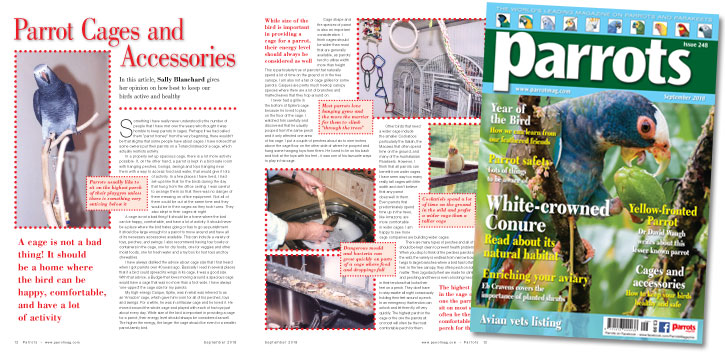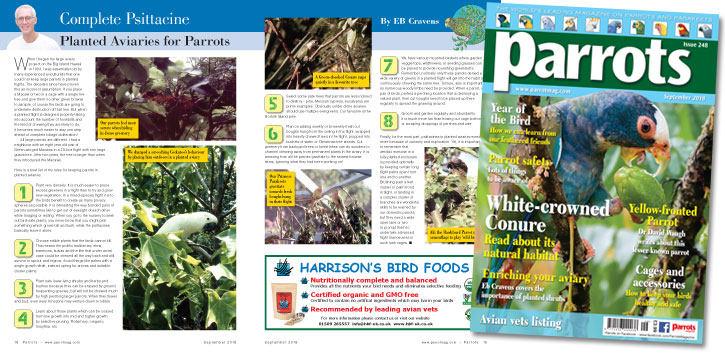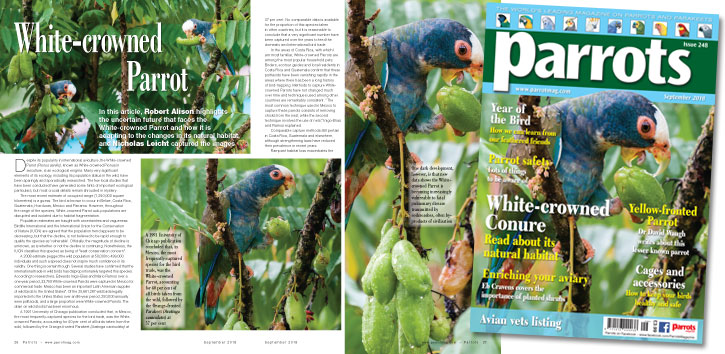
By Sally Blanchard
In this article, Sally Blanchard gives her opinion on how best to keep our birds active and healthy.
Something I have really never understood is the number of people that I have met over the years who thought it was horrible to keep parrots in cages. Perhaps if we had called them “parrot homes” from the very beginning, there wouldn't be that stigma that some people have about cages. I have noticed that some owners put their parrots on a T-stand instead of a cage, which actually restricts activity.
In a properly set up spacious cage, there is a lot more activity possible. If, on the other hand, a parrot is kept in a bird-safe room with hanging perches, boings, swings and toys hanging near them with a way to access food and water, that would give it lots of activity. In a few places I have lived, I had set-ups like that for the birds during the day that hung from the office ceiling. I was careful to arrange them so that there was no danger of them messing on office equipment. Not all of them could be out at the same time and they would be in their cages as they took turns. They also slept in their cages at night.
Buy Now!

Complete Psittacine by Eb Cravens
When I began my large aviary project on the Big Island Hawaii in 1993, I was essentially told by many experienced aviculturists that one could not keep large parrots in planted flights. The decades since have proven this an incorrect assumption. If you place a Macaw or two in a cage with a single live tree and give them no other green browse to sample, of course the birds are going to undertake destruction of that tree. But when a planted flight is designed properly taking into account the number of hookbills and the kind of chewing they are likely to do, it becomes much easier to stay one step ahead of complete foliage obliteration!
All large parrots are different. I had a neighbour with an eight year old pair of Green-winged Macaws in a 20-foot flight with one large guava tree. After two years, the tree is larger than when they introduced the Macaws.
Here is a brief list of my rules for keeping parrots in planted aviaries:
Buy Now!

Robert Alison and Nicholas Leicht
In this article, Robert Alison highlights the uncertain future that faces the White-crowned Parrot and how it is adapting to the changes in its natural habitat, and Nicholas Leicht captured the images.
Despite its popularity in international aviculture, the White-crowned Parrot (Pionus senilis), known as White-crowned Pionus in aviculture, is an ecological enigma. Many very significant elements of its ecology, including its population status in the wild, have been sparingly and sporadically researched. The few local studies that have been conducted have generated some hints of important ecological particulars, but most crucial details remain shrouded in mystery.
The most recent estimate of occupied range (1,290,000 square kilometres) is a guess. The bird is known to occur in Belize, Costa Rica, Guatemala, Honduras, Mexico and Panama. However, throughout the range of the species, White-crowned Parrot sub-populations are disrupted and isolated due to habitat fragmentation.
Buy Now!

By Vivian Miller
In this article, Vivian Miller highlights some basic considerations to keep your parrot physically and emotionally safe and healthy.
Establish a good relationship with a competent avian veterinarian who you trust to handle your parrot in a gentle manner, and take it in for an annual check-up.
�Get into the habit of observing your parrot’s physical condition on a daily basis. Check its weight, look at its eyes, its nares, and its posture. Check its breathing band its droppings. Keep track of any changes and if they seem significant, talk to your avian vet..
Buy Now!




